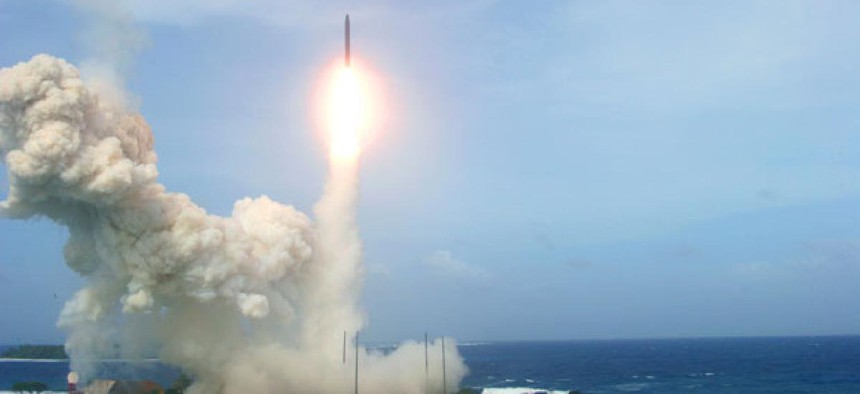Pentagon to Field Additional Ballistic Missile Interceptors in Alaska

A U.S. ballistic missile interceptor takes off in a Jan. 26 flight test from California. Missile Defense Agency/AP
The 14 new interceptors at Fort Greely in Alaska and a planned radar installation in Japan are intended to counter the missile danger posed by North Korea.
The U.S. Defense Department intends to bring the number of ballistic missile interceptors deployed in Alaska and California up to 44, Reuters quoted Pentagon chief Chuck Hagel as saying on Friday.
The 14 new interceptors at Fort Greely in Alaska and a planned radar installation in Japan are intended to counter the missile danger posed by North Korea.
Funds for the added interceptors and work on new kill vehicle technology would come via a "restructuring" of development of a separate future-generation missile that was to be deployed in Europe, Hagel said. His comments suggested the Pentagon did not intend to move ahead with the Standard Missile 3 Block 2B.
The Obama administration capped Ground-based Midcourse Defense interceptor deployment at 30 upon taking office in 2009 as it focused antimissile efforts on Europe. Today there are 26 missiles at Fort Greely and four at Vandenberg Air Force Base in California.
North Korea, stung by new U.N. Security Council sanctions over its Feb. 12 nuclear test, has threatened to hit the United States with nuclear weapons.
"The United States has missile defense systems in place to protect us from limited ICBM attacks, but North Korea in particular has recently made advances in its capabilities and has engaged in a series of irresponsible and reckless provocations," Hagel said in prepared comments to reporters. "Specifically, North Korea announced last month that it conducted its third nuclear test, and last April displayed what appears to be a road-mobile ICBM. It also used its Taepodong 2 missile to put a satellite in orbit, thus demonstrating progress in its development of long-range missile technology."
While the North has been advancing its missile efforts, there is yet no definitive evidence that it possesses ICBMs or has been able to wed nuclear warheads to its missiles.
It will require roughly $1 billion to complete the new plan, the Associated Press quoted Defense Undersecretary James Miller as saying. Installation at Fort Greely is scheduled to be completed by September 2017. Hagel noted troubles in trials of the GMD interceptors and said sufficient testing would take place before the new weapons are put into place.
"After wasting years and millions of taxpayer dollars, the Obama administration apparently has begun to realize the shortcomings of its missile defense strategy," House Armed Services Committee member Michael Turner (R-Ohio) said in a Friday press release before Hagel's press conference. "Simply slashing funding of a key part of the defense of our homeland doesn't make us safer. ... The building of a missile defense site on the East Coast is the next logical and prudent step to ensure we can counter the rising threat to the homeland" from nations including Iran and North Korea.
Hagel noted that the Pentagon is moving ahead with congressionally mandated environmental impact assessments on locations for a possible third Ground-based Midcourse Defense site in the United States. "While the administration has not made any decision on whether to proceed with an additional site, conducting environmental impact studies will shorten the timeline for construction should that decision be made," he said.
The Pentagon appears to be curbing what has been intended as a four-phase plan for deployment of SM-3 missile interceptors and associated technology to Europe. The final segment of the project was to be the developmental SM-3 Block 2B, which was intended to have a limited capacity to eliminate ICBMs.
"The purpose was to add to the protection of the U.S. homeland already provided by our current GBIs [ground-based interceptors] against missile threats from the Middle East," Hagel said. "The timeline for deploying this program had been delayed to at least 2022 due to cuts in congressional funding. Meanwhile, the threat matures. By shifting resources from this lagging program to fund the additional GBIs as well as advanced kill vehicle technology that will improve the performance of the GBI and other versions of the SM-3 interceptor, we will be able to add protection against missiles from Iran sooner while also providing additional protection against the North Korean threat."
He said that Washington remains intent in its commitment to NATO missile defense operations, and that the remainder of the phased adaptive approach would protect all alliance states in Europe by 2018.
One Obama administration source told Fox News earlier in the week that "anyone who suggests we should have stayed the course" with the Bush-era plan for 44 GMD missile interceptors is just providing "Monday morning quarterbacking."
“What we were defending against (from North Korea) four years ago was a single rogue missile, now with the mobile missile developing you have got to be able to counter multiple missile threats … so you have to expand your capability," the official said in apparent reference to the North's KN-08 missile.
NEXT STORY: Bipartisan Team Introduces FOIA Reform


